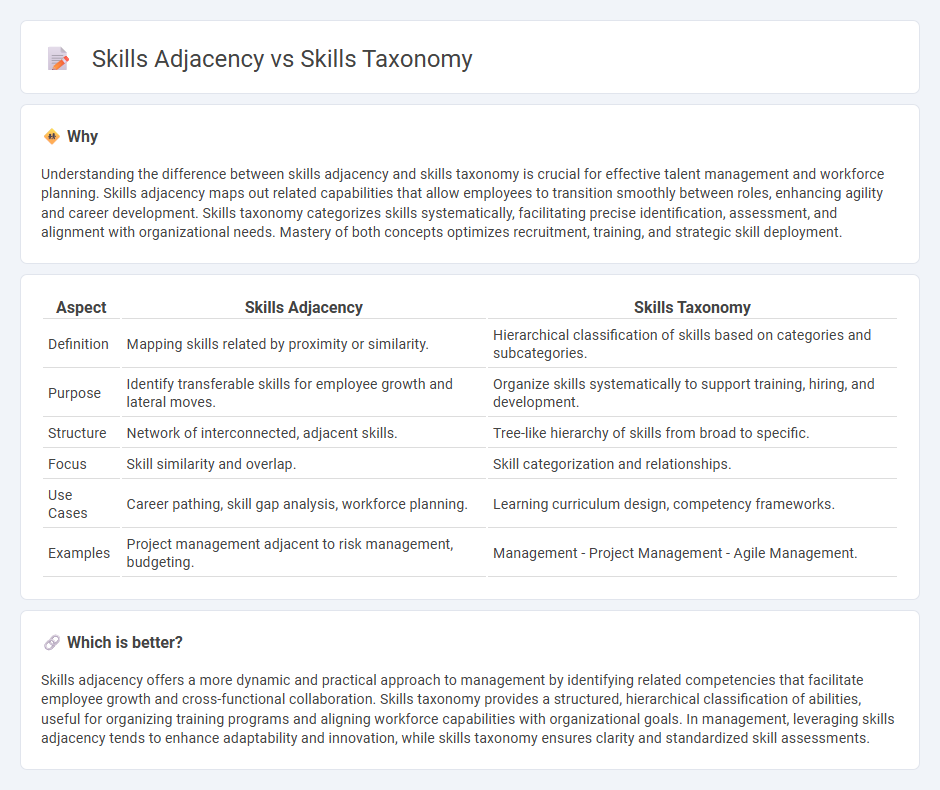
Skills adjacency refers to the proximity and transferability between related skills that enable employees to expand their capabilities efficiently, while skills taxonomy organizes skills into a hierarchical structure for better classification and management. Understanding the balance between skills adjacency and taxonomy helps organizations optimize workforce development and strategic talent deployment. Discover how integrating both concepts can enhance your management practices.
Why it is important
Understanding the difference between skills adjacency and skills taxonomy is crucial for effective talent management and workforce planning. Skills adjacency maps out related capabilities that allow employees to transition smoothly between roles, enhancing agility and career development. Skills taxonomy categorizes skills systematically, facilitating precise identification, assessment, and alignment with organizational needs. Mastery of both concepts optimizes recruitment, training, and strategic skill deployment.
Comparison Table
| Aspect | Skills Adjacency | Skills Taxonomy |
|---|---|---|
| Definition | Mapping skills related by proximity or similarity. | Hierarchical classification of skills based on categories and subcategories. |
| Purpose | Identify transferable skills for employee growth and lateral moves. | Organize skills systematically to support training, hiring, and development. |
| Structure | Network of interconnected, adjacent skills. | Tree-like hierarchy of skills from broad to specific. |
| Focus | Skill similarity and overlap. | Skill categorization and relationships. |
| Use Cases | Career pathing, skill gap analysis, workforce planning. | Learning curriculum design, competency frameworks. |
| Examples | Project management adjacent to risk management, budgeting. | Management - Project Management - Agile Management. |
Which is better?
Skills adjacency offers a more dynamic and practical approach to management by identifying related competencies that facilitate employee growth and cross-functional collaboration. Skills taxonomy provides a structured, hierarchical classification of abilities, useful for organizing training programs and aligning workforce capabilities with organizational goals. In management, leveraging skills adjacency tends to enhance adaptability and innovation, while skills taxonomy ensures clarity and standardized skill assessments.
Connection
Skills adjacency identifies closely related abilities that facilitate efficient skill development, while skills taxonomy organizes these skills into hierarchical categories based on function and proficiency. In management, leveraging skills adjacency within a well-structured skills taxonomy enhances workforce planning by enabling targeted training and seamless role transitions. This integration supports strategic competency mapping, ensuring managers cultivate complementary skills to drive organizational performance.
Key Terms
Competency Framework
Skills taxonomy organizes competencies into hierarchical categories based on proficiency and domain relevance, while skills adjacency maps relationships between related skills to identify potential growth areas and skill transferability. In competency frameworks, combining taxonomy and adjacency enhances talent development by providing structured pathways and highlighting interrelated competencies critical for workforce agility. Explore how integrating skills taxonomy with adjacency can optimize your competency framework for strategic learning and development initiatives.
Skill Mapping
Skills taxonomy organizes competencies into hierarchical categories based on relatedness and proficiency levels, enabling structured skill identification and development within organizations. Skills adjacency highlights the relationship and transferability between similar or complementary skills, facilitating personalized learning paths and efficient reskilling strategies. Explore how integrating skills taxonomy with adjacency mapping can optimize your talent management and workforce planning.
Transferable Skills
Skills taxonomy categorizes and organizes skills into structured hierarchies, aiding in the identification of core competencies within specific domains. Skills adjacency emphasizes the relationship and transferability between skills across different fields, highlighting how transferable skills like critical thinking or communication enable career mobility. Explore more to understand how leveraging both approaches maximizes workforce adaptability and talent development.
Source and External Links
What's a Skills Taxonomy (vs. Ontology)? And Why Having One Makes HR Easier - A skills taxonomy is a hierarchical framework that categorizes and organizes skills into groups and subgroups, aiding in workforce assessment and training planning.
Skills Taxonomy: The Key to Building a Future-Ready Workforce - Developing a skills taxonomy involves identifying core skills, categorizing them effectively, and aligning them with organizational goals to create a future-ready workforce.
Everything You Need To Know About a Skills Taxonomy - A skills taxonomy is a structured, hierarchical list of business skills, providing clarity through skill descriptions and mapping to identify skill gaps and support workforce development.
 dowidth.com
dowidth.com